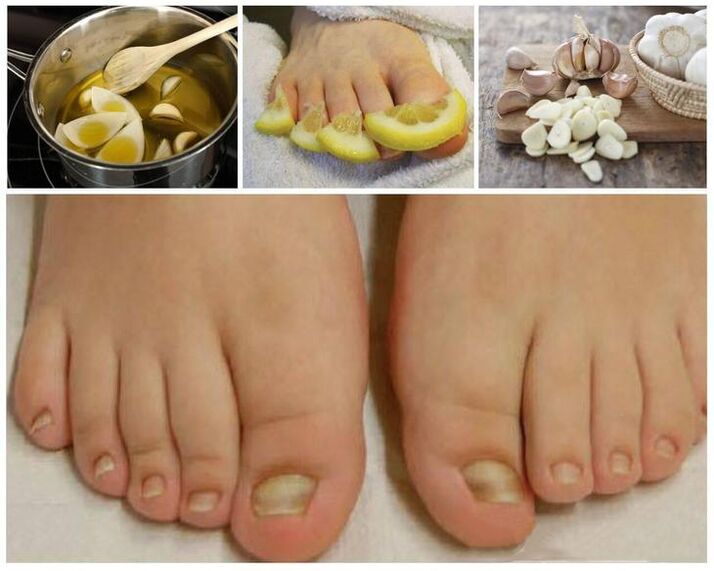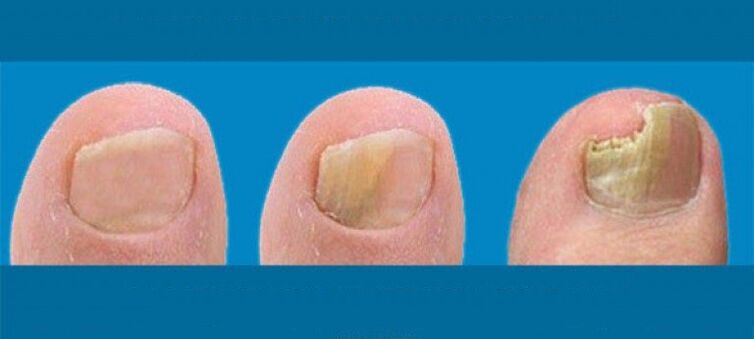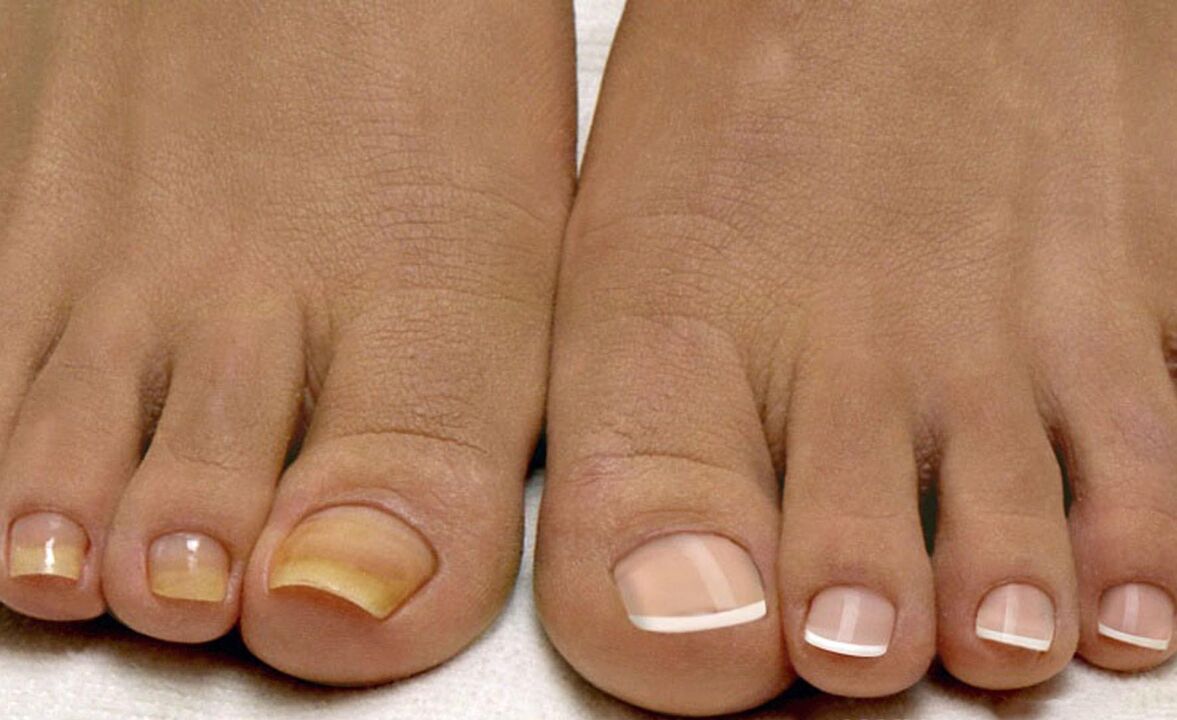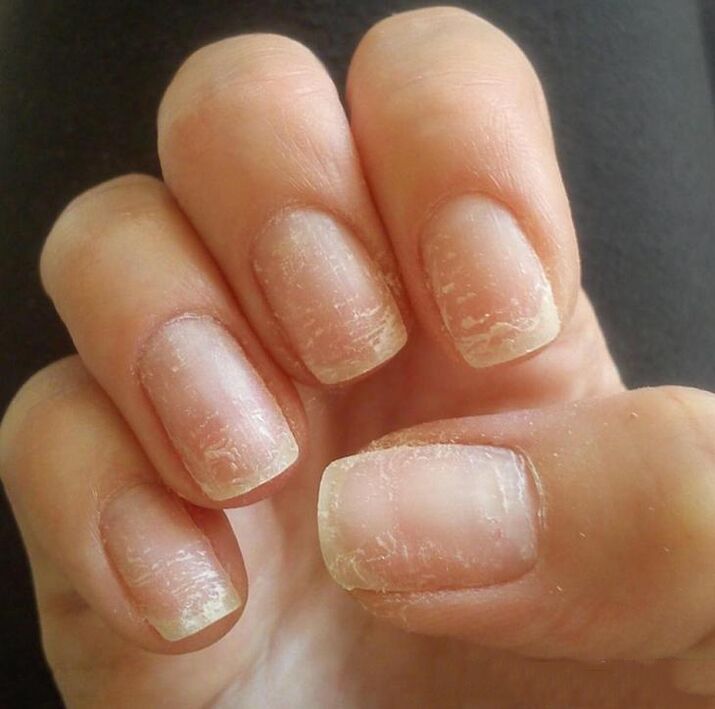
A fungal infection can affect absolutely any part of the body.Fungi, as well as other bacteria and microorganisms, are always present in the human body and on the skin in strict balance.When the number of fungi is increasing for various reasons, the infection can begin.
OnihyComyCosis, called and fungal onichia, is a fungal infection that affects nails either on their feet or on their hands.It develops slowly, so it is very difficult to notice any signs of the disease.
Why is it developing?
The fungal nail infection starts from the moment the number of fungus inside, below or on the nails is rapidly increasing.Fungi love a warm and humid environment, so during any suitable environment starting to multiply intensively.The nail mushroom occurs due to the same fungi that causes bordered eczema, micoso and cutting lichens.
Mushrooms, peacefully living in both the body absolutely any person, can cause nail infection.If you are in touch with someone who has this disease, it can be transferred to you.According to the American Academy of Dermatology, fungal infections often affect legs on their feet than in their arms, because the fingers are more common in a warm and wet environment.
If you get used to making manicure and pedicure in the cabin, it is worth learning that staff disinfects tools and how often it does.Goodbye for manicure and pedicure, such as nail and rod files, can be a source of infection, which in any case, transfer to another person without proper disinfection.
Who can be infected?
There are many causes of fungal nail infection, and each is processed in your own way.Most of these reasons can naturally prevent, but there are some factors that significantly increase the risk of this infection.The highest risk of developing nail fungus is people who:
- are sick with diabetes;
- have a disease that weakens blood circulation;
- More than 65 years;
- have overhead nails;
- Visit public baths, swimming pools;
- have a nail injury;
- have been injured in the skin around the nail;
- The legs are constantly in the moisture or sweating continually;
- have a weak immune system;
- They wear narrow and cramped shoes such as sneakers and boots.
A fungal infection is more common in men than in women, and more often in older people than in children.If someone is sick in your family with fungi, then that will most likely have it in the future.Older people have the highest risk of developing this infection, because blood circulation is deteriorating with age, and nails grow more slowly and become thicker.
What does the nail fungus look like?
A fungal infection can affect part of the nail, a whole nail or a few nails at once.
Visible signs

Explicit symptoms Fungi nails are:
- Nail stratification called Purebal Hyperkeratosis;
- White or yellow stripes on nails, which are called side onyhykosis;
- crushing ends of nails or angles, called distal onychomicosis;
- Excessive white spots on nails, after which holes remain;
- The appearance of yellow places near the nail holes, which is called proximal onykromicosis;
- Loss of nail.
General signs
Common symptoms of fungal infection are considered:
- Deformation of nail plates, the nail is not held well in place;
- an unpleasant smell from an infected nail;
- crushing or a pinnacle.
How to find out if I have nail fungus?
The only way to confirm the diagnosis is to advise with a doctor, because some other infections can also affect nails and have symptoms similar to fungals.In such cases, a scraping from the nail is usually taken, which is sent to the laboratory for detailed analysis and explanation of the diagnosis.
When is the time to visit a doctor?

In most cases, nail fungus is considered a purely cosmetic problem.However, in some people fungal infection can cause serious complications.So, in people with diabetes, the nail mushroom can further lead to the street of the foot or other problems with your legs.According to the 2012 Study, chronic nail fungus is considered one of the main risk factors and key conditions for the development of bacterial cellulite legs.
Therefore, if you have a diabetes or impaired immune system, you should not use domestic medications to treat nail fungus.Contact your doctor for help to learn how to treat a fungus on your feet and how to treat.
How to cure nail fungus to your feet?
Excessive medications are usually not recommended for treating fungal nail infections, because they do not provide reliable results.Instead, your doctor prescribes oral antifungal drugs.These drugs are very effective, but they have a lot of side effects of gastric disorder and dizziness on skin and jaundice problems.
You can use other antifungal agents, such as antifungal lacquer or nail base.It applies to the nail in the same way as regular nail polish.Depending on the type of fungus, as well as the degree of damage to the nail plate, this tool can be used for several months.
Unfortunately, treatment does not guarantee complete quickly releases a fungal infection.In almost half of the cases, the nail mushroom returns again.Complications are not excluded.Maybe, therefore, many people are more likely to resort to help traditional medicine.
Folk drugs for fungi
The fungus on the leg nails is not at all that you would like to see on your feet, especially in summer during the season on the beach.Therefore, we decided to collect the 10 most popular and more efficient means of traditional medicine to learn how to treat a nod's fungal on your feet.
Extract Snake Highlander

Extract Highlander Snake is a natural antifungal agent.Highlander snakes refers to sunflower family plants.Study conducted in 2008. It showed that extract also enters into force against fingers for nails on their feet, as a cyclopyroxic drug prescribed prescription.To get rid of fungal infections on your feet with this method, you need to adhere to the following schemes: In the first month of treatment, apply the affected area every third day, in the second month twice a week and within the third month of the seventh week.
Tea oil
Tea oil is also called melaleuka, an essential oil that has an antifungal and antiseptic effect.It is also recommended to treat nail fungus.You just need to inflict tea oil with teavac directly to a painful nail twice a day with a cotton covering.
Usually oregano oil
Usually the oil contains Timol.Timol has an antifungal and antibacterial effect.To treat a fungus on leg nails, apply the oil twice a day with cotton swab.Some people use ordinary oregano oil, along with oil oil.Both products have a strong effect and can cause irritation and allergic reactions, so the combination of these oils is not recommended.
Olives extract
It is believed that an active substance in olive extract, oleuroperoin has antifungal, antimicrobial and immunomodulative effects.You can inflict olive extract directly to the nail fungal or drinking capsule.Despite the fact that the treatment of capsules is considered more efficient than the application of olive oil extract.Take 1-3 food capsules 2 times a day.Through treatment, drink a lot of fluid.
Oil oils

Oil oils, such as olives and sunflower, were obtained by saturating gaseous ozone.According to the 2011 study, ozone effect in low concentrations for a short time can kill many microorganisms, such as mushrooms, yeast and bacteria.In the second study, it was found that the volatile sunflower oil has been shown more efficiently in the treatment of fungal nail nail infection, but a ketoconasolic antifungal drug sold in accordance with the recipe.
To treat fungus on foot nails with armored oil, treat your nail twice a day.
Vinegar
There is no scientific evidence that cheese helps to treat fungi.However, this is a pretty safe remedy for the home home you can try.To do this, make baths with warm leg legs with vinegar, diluting 1 part of vinegar in 2 parts of water.The procedure should be performed daily for 20 minutes.
Oral cavity freshener
The composition of the refresher includes menthol, Timol and eucalyptus that have antibacterial and antifungal properties.It may be so popular about that among people in treating nail fungus on their feet.You just need to keep the problem in the box with a freshener for 30 minutes.The procedure is done on a daily basis.
Garlic

As you know, garlic has an antifungal and antimicrobial effect.To get rid of fungal infections, apply chopped garlic garlic to problem nails 30 minutes a day.If you don't like the smell, you can try the capsules with garlic.Take strictly as directed.
Complete the settings on a diet
Our health depends on what you eat.The more used foods you consume, the greater the probability that your body will deal with different harmful factors and diseases, including nail fungus.
Eat food required for the body for normal functioning, namely:
- Yogurts are enriched with probiotics;
- enough protein for normal nail growth;
- Iron enough to prevent nail frailness;
- Food, rich in necessary fatty acids;
- Food rich in calcium and vitamin D (weak -fat dairy products).
In this case, household medications can be supplied that they are more efficient than medications that are released according to the recipe in the treatment of a mild and moderate phase of the disease flows.Obviously, traditional medicine funds have less side effects, but their efficiency is not scientifically proven.Many factors should be taken into account in the treatment of a fungal nail infection, such as the permeability of nail, severity of disease and the general health.

Treatment with the help of traditional medicine usually lasts longer than medication treatment.The first results can occur only after a few months.It often happens that the problem is returning again.
How to prevent fungal nail infection
Only a few simple changes in life mode will protect against this serious and boring infection.Take care of your nails, cut them on time and keep them cleaning.Try not once again not to injure your skin around the nails.If your hands are often in contact with water, place rubber gloves.
Here are some tips on how to protect yourself from the fungus:
- Use antifungal sprays and powders regularly;
- Wash your hands after contact with infected nails;
- Wipe your legs dry after shower, especially in the area between your fingers;
- make manicure and pedicure in proven salons;
- Use only your manicure tools and pedicure;
- Wear socks for the season to prevent you from pasting your legskin skin;
- Do not go barefoot in public places;
- Refuse artificial nails and color nails with easy.
What to expect in the future?
Don't expect the current score.In some people, treatment cannot help immediately and it takes several courses or remedies.A fungal infection is considered cured only if the new nail is grown without signs of fungus.But that doesn't guarantee that fungal infection will no longer return.In more advanced cases, the nail is subjected to a constant fungus infection, and will have to be removed.
The main complications of fungal infection are:
- Reinforcement;
- Removing the infected nail, and once and forever;
- Bleaching of the nail affected by the fungi;
- spreading infection to other parts of the body, and even in the bloodstream;
- Development of bacterial skin infection, called cellulite.
You must contact your doctor anyway, especially if you have diabetes and nails on your feet.People with diabetes are exhibited at high risk of developing serious complications, so don't waste your time and schedule a meeting with a doctor.

















